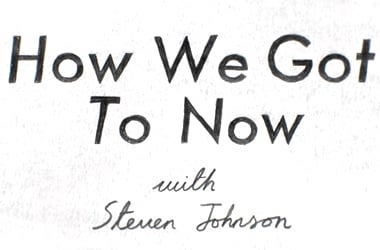

The fifth episode of How We Got To Now focuses on the idea of cold. On the day it first aired, we asked Steven Johnson for some behind-the-scenes stories.
What was the most surprising idea you discovered in making this episode?
I think one of the most amazing stories–of the whole series really–is about the “Ice King” Frederic Tudor, who ultimately made hundreds of millions of dollars in today’s currency shipping blocks of frozen ice from New England lakes all around the world–as far as Bombay and Rio. For a period of the 19th century, natural ice was the second biggest export from the United States, behind cotton. It’s a strange thing about the technologies of cold: In the middle of the 19th century, in a time of steam engines and telegraphs, the most advanced form of artificial cold involved cutting chunks of frozen water out of a lake.
Many of the ideas you discuss developed a long time before they had their biggest impact. What was the biggest “slow hunch” in this episode?
I’d say it was Clarence Birdseye’s invention of flash freezing, which would create an entire industry of frozen foods and would eventually become a central technology in the freezing of human eggs and embryos involved in IVF. He spent 10 years tinkering with the idea with no clear vision of where he was headed, including a period of ice fishing in Labrador, which we recreated for the show. (That was by far the coldest day of shooting during an entire episode devoted to cold!)
What was the most incredible moment in filming this week’s episode?
We went to the indoor ski slope in Dubai–skiing in the middle of the Arabian desert, where it was 110 degrees outside. It was incredible, and also completely insane. It shows, I think, both how far we have come in the technologies of cold in just 150 years and also that sometimes we have a tendency to go too far! The very first take we did for the entire series was shot on the roof of SkiDubai, with me wearing a parka and a harness in incredibly hot weather. Fortunately, it all got a little easier as the shoots went on.
Was there a story or idea that you loved that didn’t make it into the final episode?
We had fun delivering ice with a family in New York whose business has been delivering ice for a hundred years, but we ended up not having room for them in the U.S. version. The BBC2 version is a few minutes longer, so I believe they managed to make it in.
This week’s episode is about cold. What is the most important idea or innovation on this theme emerging right now?
When I was at the Gates Foundation last month, I saw a couple of devices that were capable of keeping vaccines chilled for months without any external power source–just an initial supply of ice. This is a great benefit in hot rural environments that need vaccines but don’t often have the technology to keep them at the proper temperature for storage. I loved this because it was effectively back to Tudor and the early days of the ice trade: no electricity, no elaborate refrigeration technology, just simple ice. But in this case, it’s ice being used to save lives.


How We Get To Next was a magazine that explored the future of science, technology, and culture from 2014 to 2019. Steven Johnson’s How We Got To Now was published by Riverhead Books in 2014, and adapted into a six-part TV show by Nutopia for PBS in 2015. Click the logo to read more about how the show was made.
